I remember the first time a client asked me to source chassis trailers for their freight operation. I nodded like I knew exactly what they needed. Truth is, I didn’t.
That moment pushed me to dig into every detail about chassis trailers. I wanted to be sure I’d never be caught off guard again.
Since then, I’ve worked with logistics teams, visited trailer yards, and reviewed real-world use cases across industries. What you’re getting here isn’t theory. It’s tested info from the ground.
This guide covers what a chassis trailer is, how it works, when you need one, and how it compares to other trailer types. If you’re trying to figure out if a chassis trailer fits your business, you’re in the right place.
So, let’s get into it!
1. What is a Chassis Trailer?
A chassis trailer is a simple, load-bearing frame used to transport intermodal containers. It’s built to carry standard-sized shipping containers efficiently from ports to warehouses or between terminals. The container locks onto the chassis using twist locks, and the whole setup is ready to move.
Why It Looks So Basic
A chassis trailer has no flooring, sidewalls, or roof because it’s not meant to carry loose cargo. It’s made specifically for containers, which are already self-contained units.
This stripped-down design keeps it light, fast to load, and easy to maintain. It’s function over form—and that’s what makes it useful.
How It Fits Into the Transport Chain
- Chassis trailers play a big role in intermodal logistics. They’re used in ports, rail yards, and freight terminals to move containers quickly.
- Without them, container handling would be a slower and more expensive process, requiring more manual labor and equipment.
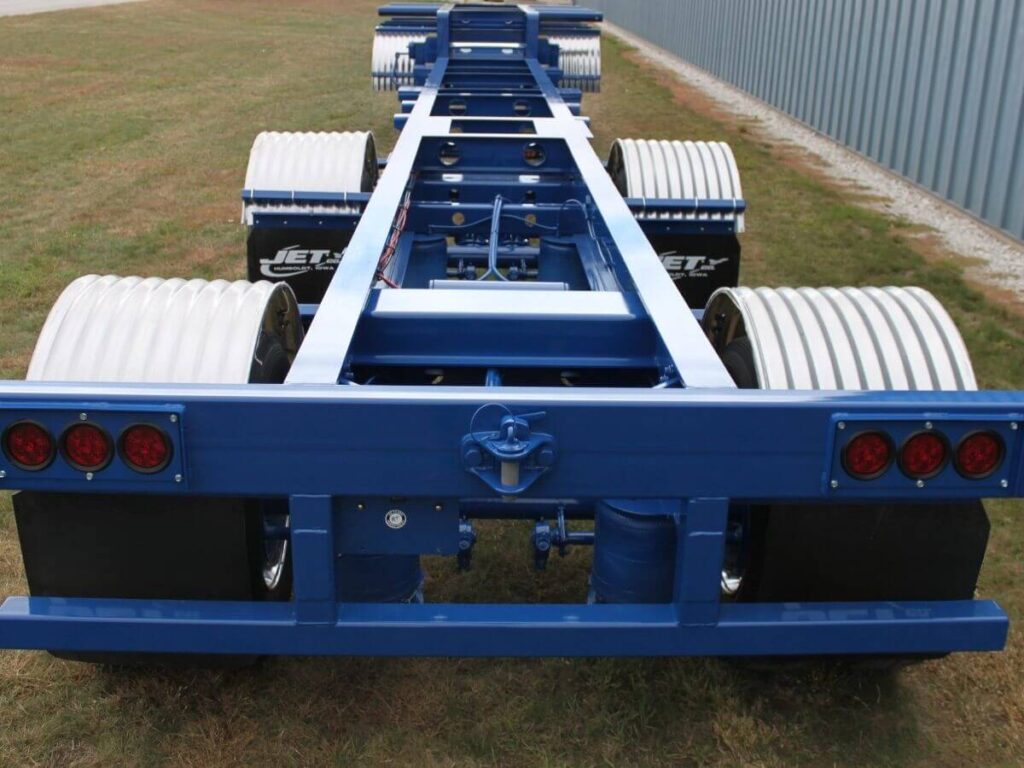
2. Benefits of Using Chassis Trailers
If you work with container transport, you know how quickly delays can throw everything off. That’s where chassis trailers quietly do a lot of heavy lifting.
Faster Container Movement
Speed matters when your schedule’s packed and customers are waiting. Chassis trailers let you move containers without wasting time on extra loading steps. You don’t need to open the container or handle loose cargo. Just lock it onto the chassis and you’re on your way. That simplicity adds up fast when you’re managing multiple shipments a day.
Lower Equipment and Labor Costs
No one wants to throw money at equipment that doesn’t get used. With chassis trailers, you avoid extra machinery and labor because containers are already packed. You don’t need forklifts or dock crews rehandling cargo. That means fewer people on the ground and fewer things that can go wrong. It’s a smart way to keep costs in check without cutting corners.
Better Fit for Intermodal Logistics
If your shipments touch ports, rail, or road, chassis trailers make that flow smoother. You can keep the container sealed from start to finish, no matter how many hands it passes through. That saves time, lowers risk, and avoids bottlenecks between transport modes. It also helps standardize your process, which makes things easier to scale. When every leg of the trip is aligned, you get more predictability.
Less Risk of Cargo Damage
Containers stay closed and untouched once they’re loaded. That means fewer chances for damage, loss, or mix-ups. Chassis trailers help you protect the integrity of the load without relying on extra supervision. If you’re shipping fragile or high-value goods, that matters. No one wants to deal with insurance claims over something that could have been avoided.
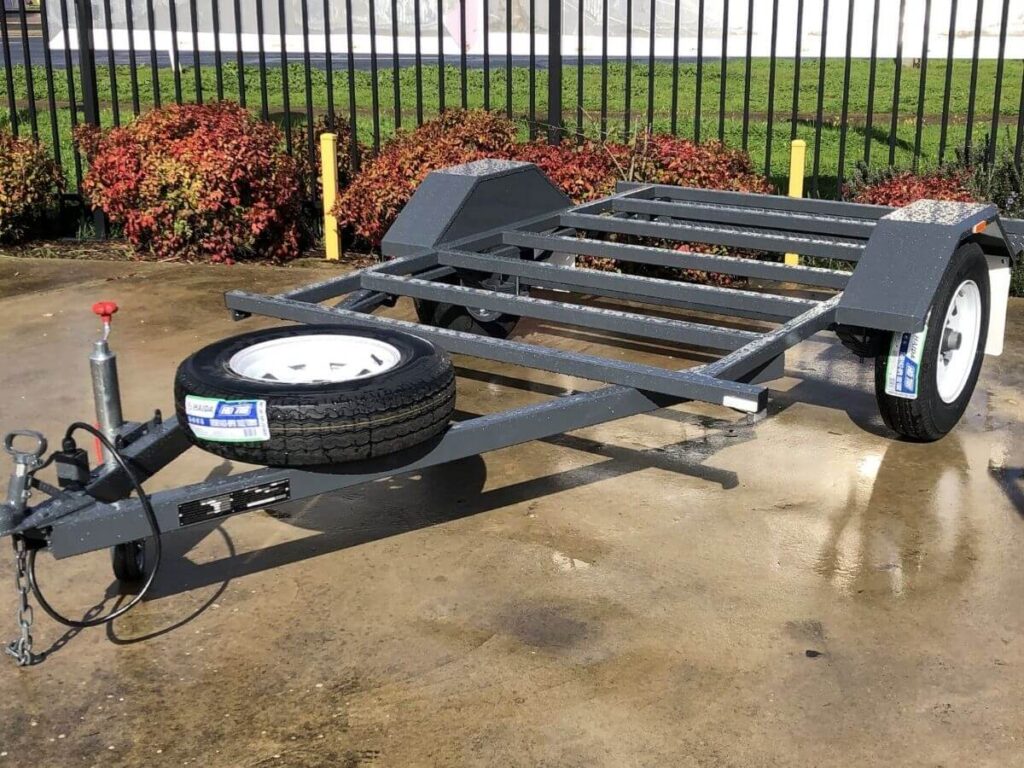
3. Key Components of a Chassis Trailer
Chassis trailers may look simple, but every part plays a role in keeping containers secure and transport running smoothly. If you’re managing fleet equipment, it helps to know what makes up the frame you rely on every day.
- Frame: The frame is the backbone of the trailer, built to support the full weight of a loaded container. It’s typically made from high-strength steel to handle rough use and heavy loads.
- Twist Locks: These are the locking mechanisms that secure the container corners to the chassis. Once locked in place, they prevent the container from shifting or sliding during transport.
- Axles and Suspension: Axles carry the weight of the load and connect the wheels to the frame. The suspension system helps absorb shock, keeping the ride stable on uneven roads.
- Landing Gear: This is the retractable support that holds the chassis upright when it’s not attached to a truck. It allows safe loading and unloading without tipping.
- Brake System: Most chassis trailers use an air brake system similar to standard trucks. It ensures the trailer stops safely and consistently, even when fully loaded.
- Rear Impact Guard; This metal bar sits at the back of the chassis to prevent vehicles from sliding underneath in a rear-end collision. It’s a basic but important safety feature.
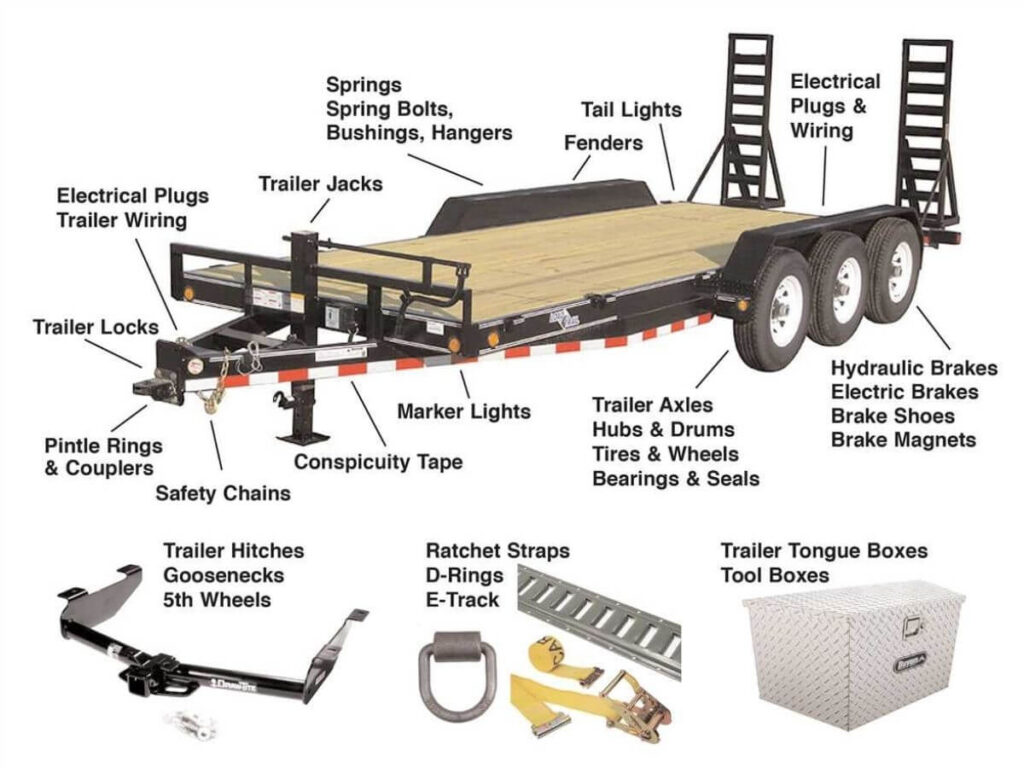
4. Types of Chassis Trailers
Not all chassis trailers are built the same. If you’re moving containers regularly, knowing the different types can help you choose the one that fits your operation best.
- Standard Chassis Trailer: This is the most common type, designed to carry one 20-foot or 40-foot container. It’s ideal for everyday port-to-warehouse moves or short-haul runs.
- Extendable Chassis Trailer: This version can slide out to fit longer containers or slide back for shorter ones. It gives you flexibility when container sizes vary from job to job.
- Tri-Axle Chassis Trailer: With an extra axle, this trailer handles heavier container loads while staying road legal. It’s often used when hauling full 40-foot containers over long distances.
- Tandem Chassis Trailer: This one uses two axles for better balance and smoother travel. It’s a good choice for medium loads or when you’re running mixed container sizes.
- Tank Container Chassis: Built to carry tank-style containers for liquids or chemicals. The frame design offers better stability and keeps the container securely in place.
- Gooseneck Chassis Trailer: The lowered front end allows the container to sit lower for improved clearance and stability. This helps with taller container loads or bridge-heavy routes.
- Drop Frame Chassis Trailer: This version has a lower deck height and is great for high-cube containers. It helps keep your load within height limits without sacrificing capacity.
5. Common Uses of Chassis Trailers
Chassis trailers are built for function, not flash. If your business moves containers, chances are you’re already relying on them more than you think.
Port-to-Warehouse Transfers
One of the most common uses for chassis trailers is moving containers from ports to nearby warehouses. These trips are usually time-sensitive, and a chassis trailer keeps things moving without extra handling. The container stays sealed, reducing the chance of damage or delays. This setup works well for both imports and exports. It’s a simple solution that supports high-volume container flow.
Rail Yard Hauling
Chassis trailers also play a key role in intermodal transport, especially between rail yards and final destinations. Containers are offloaded from trains directly onto chassis trailers with minimal downtime. That makes them perfect for time-critical or long-distance cargo. Businesses that need to shift between train and truck without breaking up the load rely on this process. It’s fast, efficient, and cuts back on unnecessary labor.
Distribution Center Deliveries
When containers are headed to regional distribution centers, chassis trailers help bridge the gap. They let you move sealed units directly to facilities where sorting or repacking happens. This reduces touchpoints and keeps goods intact until the final stage. It’s especially useful in retail and e-commerce logistics, where damage and delays add up fast. The fewer hands on the cargo, the better.
Container Relocation and Storage Moves
Sometimes containers need to be repositioned or moved into temporary storage. Chassis trailers handle these internal transfers with ease. Whether it’s across a yard or to a new facility, you can move the full container without unloading it. That saves time and keeps the container contents protected. It’s a clean solution for internal logistics and storage rotation.
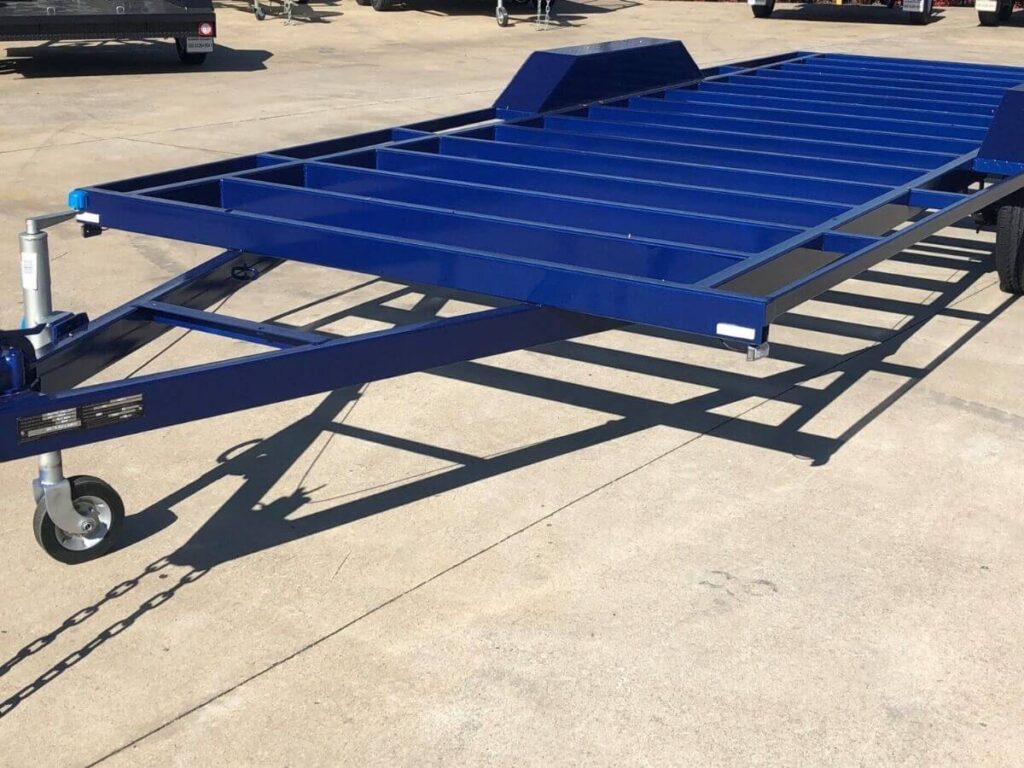
6. Maintenance and Safety Tips
Chassis trailers are built to last, but only if they’re taken care of properly. A little attention goes a long way when you’re hauling heavy loads and working under tight schedules
- Inspect Before Every Trip: Always do a walk-around before loading anything. Check for worn tires, loose twist locks, and damaged brake lines. Even small issues can turn into big problems on the road. A quick check can save you hours of downtime later.
- Check Brake and Lighting Systems: Make sure the brake system is fully functional and free from air leaks. Lights and reflectors should be clean, connected, and working. These aren’t just safety features, they’re legal requirements. Skipping this step can put your drivers and cargo at risk.
- Grease Moving Parts Regularly: Landing gear, wheel hubs, and suspension parts need regular lubrication. Without it, parts wear faster and performance drops. Greasing on schedule helps prevent breakdowns and extends the trailer’s life. It’s a simple task that makes a big impact.
- Secure the Container Correctly: Twist locks should always be checked and locked tight before hitting the road. A loose container isn’t just a safety hazard, it’s a liability. Make sure the container sits correctly on the frame and is centered. One final check before departure can prevent disaster.
- Watch Load Limits and Axle Weight: Never guess when it comes to weight. Overloading puts stress on the trailer and increases the risk of accidents. It can also lead to fines at weigh stations. Know your limits and follow them every time.
- Train Staff on Safety Practices: Maintenance means more than just mechanics—it includes driver awareness too. Make sure your team understands the basics of trailer safety. From spotting early warning signs to reporting issues, a trained crew helps keep operations smooth.
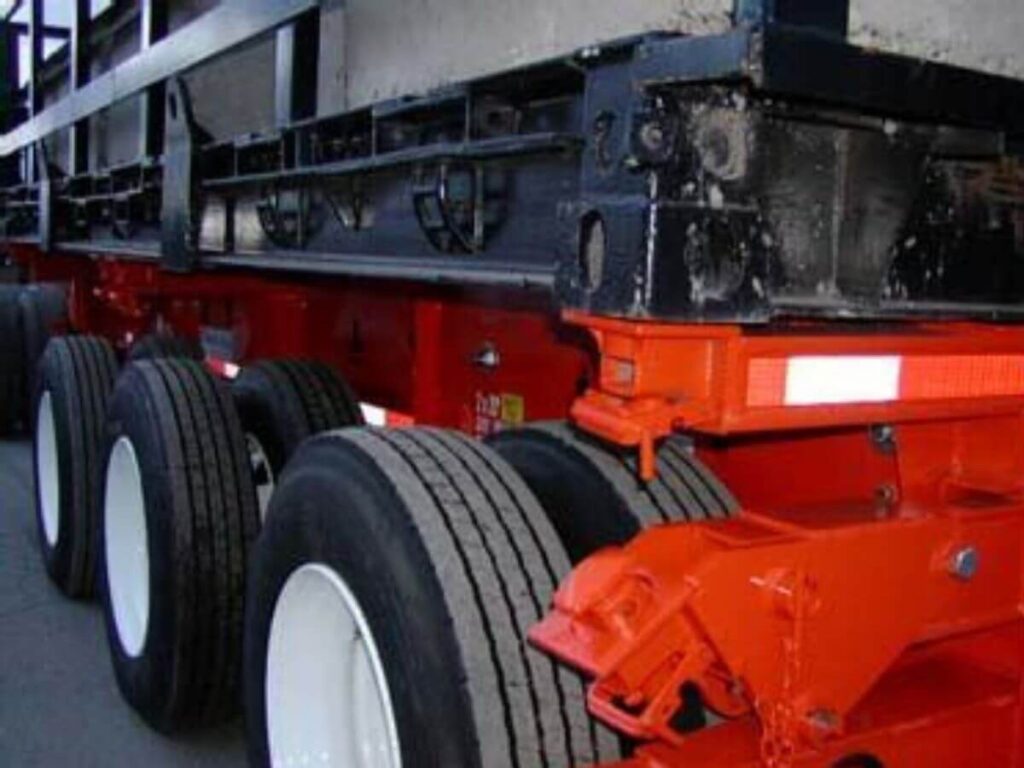
7. Factors to Consider When Buying a Chassis Trailer
Buying the right chassis trailer isn’t just about finding the lowest price. If it doesn’t fit your operation, it ends up costing more in the long run.
Match the Trailer to Your Container Types
Before anything else, think about the size and type of containers you handle most. If you’re mostly moving 20-foot containers, a standard chassis works fine. But if your loads vary or include 40-foot or high-cube containers, you may need an extendable or drop-frame chassis. Using the wrong fit can slow down operations and increase handling risks. It’s better to plan for flexibility if your needs change often.
Check for Road and Weight Regulations
Different regions have limits on trailer length, height, and axle weight. If you cross state or international borders, those rules can change quickly. Choosing a chassis that meets the widest range of regulations helps avoid penalties and delays. It also protects your equipment from wear caused by overloading. Make sure your trailer keeps you road legal wherever you go.
Evaluate Total Cost and Long-Term Use
It’s easy to focus on upfront price, but long-term value matters more. A slightly higher-quality chassis may cost more now but save you on maintenance and downtime later. Look at the frame strength, axle brand, brake system, and whether parts are easy to replace. A well-built trailer that lasts five years beats a cheaper one that breaks down in two. Think in terms of total cost over time, not just the purchase order.
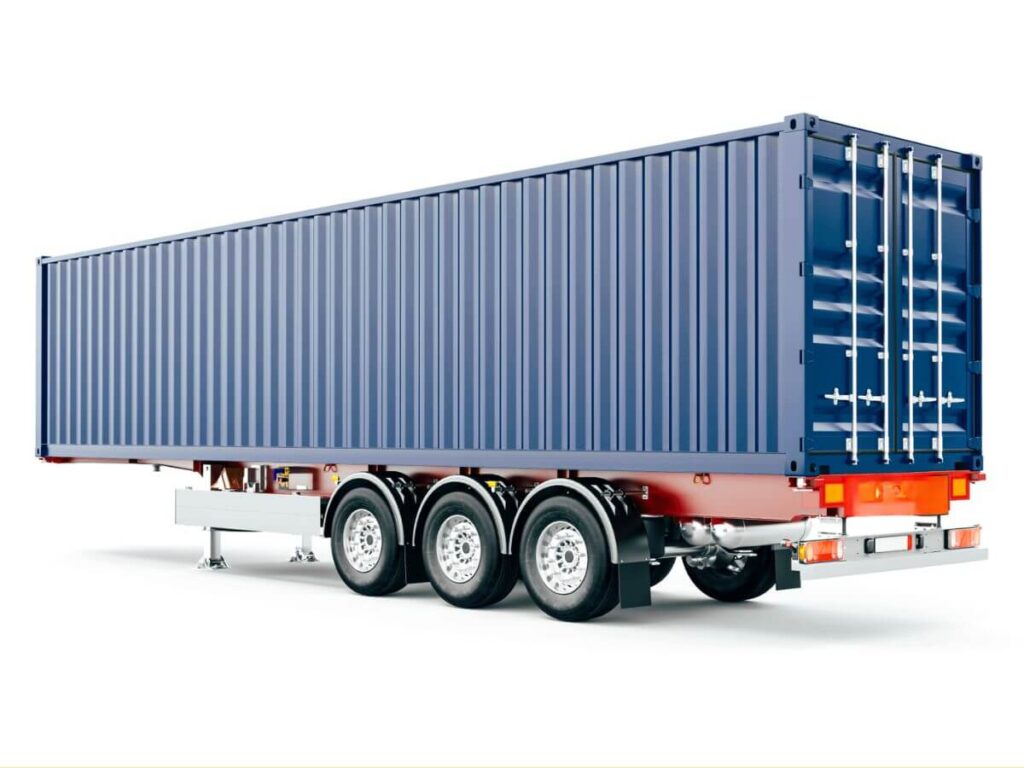
Conclusion
You’ve just walked through everything you need to know about chassis trailers.
What they are. Why they matter. How they keep goods moving.
I started off with questions. You now have answers.
If you’re serious about upgrading your fleet, don’t wait.
Smart logistics begins with smart equipment.
Let’s make it happen. Contact Rhinotrail today.


